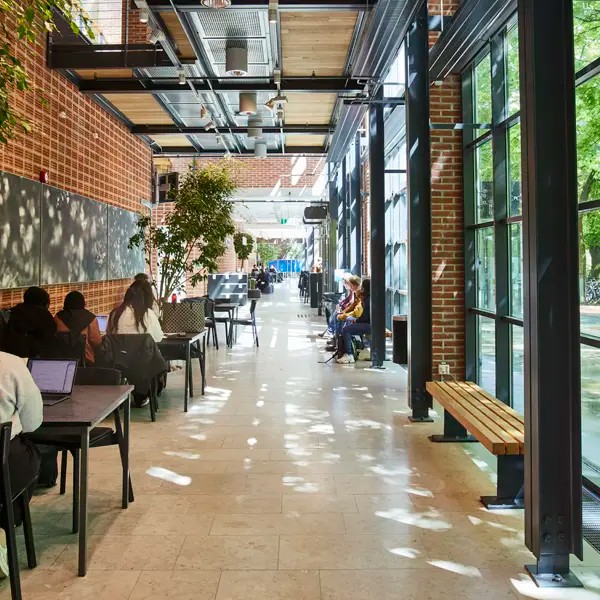
The Chalmers Women’s Association (CWA), one of Chalmers’ largest student organisations, has an extensive female network, strong business contacts and a strong dose of fighting spirit – it is working to create a more equal academia and technology industry.
"There are many outdated structures left at Chalmers, but we in the CWA can make a difference," says Anna Englund, Vice-Chair.
Sexist jokes at student union parties. Teachers answering a male student, even though a female student asked the question. Stock market events or study visits to industry where no woman’s voice is heard, and where men are in the overwhelming majority.
These are some everyday examples of how the uneven gender balance among Chalmers students can manifest itself.
“Being in the minority in a group – even if no one is directly unpleasant – always requires more energy because you need to interpret and read situations, and you can easily find yourself at a disadvantage when it can be more difficult to be assertive and ask questions. This is why we need meeting places for women in environments that are as male-dominated as Chalmers is,” says Hanna Svensson.
Inspiration and networking
In 2020, Hanna Svensson was involved in founding a new student organisation at Chalmers, the Chalmers Women’s Association (CWA). The association wants to challenge the structures and prejudices about gender that can still characterise student life for many female and non-binary students. Participation has grown steadily: today the CWA has over 500 active members and is one of Chalmers’ largest student organisations.
Three years on, Hanna Svensson talks about the CWA’s journey, together with Vice-Chair Anna Englund and event managers Jennifer Stevrell and Marie Stenelo. Building a strong network to motivate and engage students is an important goal. But it is also important to make valuable contacts in the tech industry, and to encourage students to break norms and challenge outdated stereotypes in academia and industry.
“We organise company visits to help students network with industry and get a foot in the door. We hold social events where we meet and have fun, and also inspirational events. As an example, we recently invited Nazanin Nematshahi, SMC business area director at Microsoft, to talk about everything she has gone through. She definitely provided our members with tools to take away,” says Anna Englund.
Collaboration with industry
While initially supported by Chalmers’ gender equality initiative Genie, the CWA’s resources currently come from sponsors and partnerships with the business community – mainly the Volvo Group and McKinsey & Co. The CWA is regularly approached by companies that want to start collaborations on gender equality issues.
“Many of them have clear goals that they want to achieve together with us, and the collaboration can be really excellent. However, there are also companies that have not addressed gender equality issues at all, lack their own reflections and only contact us to make themselves look good. For example, we met a male company representative who kept interrupting, took over the meeting completely and at the end said, with some surprise, “But you were actually really serious!”. In such cases, we decline collaboration. Our partners must be serious about their gender equality work, be able to represent us and champion our values,” says Marie Stenelo.
Wanting to bring change to the industry
Hanna Svensson, who now works at Volvo Cars, feels that her involvement with the CWA was extremely useful before she entered the world of work.
“My time with the CWA has made me more aware of the gender issues that exist, and has provided me with the mindset and tools to deal with them. In general, my perception is that many in the business community have got better at gender equality issues. But a lot depends on the culture and leadership, and whether there is a real determination to change outdated structures. There are still plenty of people who see gender equality as something outside their own area of responsibility and say: “that's something HR can take care of”, says Hanna Svensson.
She gives an example of a colleague who discussed gender issues on social media and was asked whether she was not concerned that this would harm her career. Frightening, say the students in the CWA, who hope they can contribute to change.
“The greater the community the CWA can build here at Chalmers, and the more we network with industry, the greater the opportunities we will have to make a difference when our students enter the world of work. We need to phase out the old way of thinking. The more I get involved, the more motivated I am to try to change the industry,” says Jennifer Stevrell.
Higher levels of victimisation among students
In 2022, a report was published on gender-based victimisation and sexual harassment in the Swedish higher education sector. It showed that female students and doctoral students are particularly at risk of victimisation, and the figures from Chalmers were also slightly higher than the average among the participating universities. For example, 16 per cent of Chalmers’ female students have experienced insulting or disrespectful comments, and 32 per cent have been asked intrusive and unpleasant questions about their private lives. Women are also much more likely than men to be challenged and accused of incompetence.
“Those are not comforting statistics. During the #MeToo movement, there were many stories from students about victimisation and sexual harassment. Even though some things have changed, many outdated structures remain at Chalmers,” says Anna Englund.
The CWA believes that Chalmers bears considerable responsibility for ensuring that awareness of gender equality issues is raised across all parts of the university.
“Genie does an excellent job, but it is fundamentally wrong that this initiative should be an “extra” endeavour, almost like an external party, when these issues need to be integrated into the entire organisation. We believe that discussions and training on gender equality issues should be a natural and compulsory part of all programmes and courses,” says Marie Stenelo.
The involvement of men is also important
Equally, the CWA is convinced that the involvement of women alone is not enough. To achieve real change, men also need to get on board, not only from the point of view of democracy, but also because it benefits them as well.
“Groups that are more diverse tend to be more successful. We need more male role models to show that this is an important and personal issue for men as well: it is about their fellow students, sisters and mothers. It may take courage to challenge structures, such as speaking up if you hear comments that you feel are unacceptable. But the more people take that step, the more people will follow. We are unable to do anything about the past, but men can influence the future of the industry they will be part of,” says Jennifer Stevrell.
Read more about the CWA
Gender distribution in education
In 2022, Chalmers had:
• 10,595 full-time students, of whom 33 per cent were women and 67 per cent were men
• 615 teachers, of whom 27 per cent were women and 73 per cent were men.
Some extracts from the report and specific figures for Chalmers:
• 28 per cent of female students at Chalmers have once, twice or occasionally been subjected to sexual invitations or been asked to meet outside work in a way that was uncomfortable or unpleasant. The figure for Sweden’s entire higher education sector is 14 per cent. For men, the figures are 10 per cent and 7 per cent respectively.
• 16 per cent of Chalmers’ female students have experienced insulting or disrespectful comments. The figure for men is 11 per cent. The figure for the entire higher education sector in Sweden is 11 per cent for women and 10 per cent for men.
• 32 per cent of Chalmers’ female students have experienced intrusive and unpleasant questions about their private life. The figure for men is 17 per cent. The figures for Sweden’s entire higher education sector are 20 per cent and 17 per cent respectively.
• 14 per cent of Chalmers’ female students and 6 per cent of male students say that someone has touched them in a sexual way, such as by grabbing, holding, kissing, hugging or caressing them in an uncomfortable or unpleasant way. The figure for Sweden’s entire higher education sector is 5 per cent for women and 3 per cent for men.
According to Chalmers’ internal survey, the Student Barometer, the biggest difference between women and men is the question ‘I experience Chalmers as a university free from discrimination’ (Yes: men 83 per cent and women 75 per cent).
Read the report "Gender-based victimisation and sexual harassment in the Swedish higher education sector"
Read the internal report that analyzed the data specifically for Chalmers:

